-
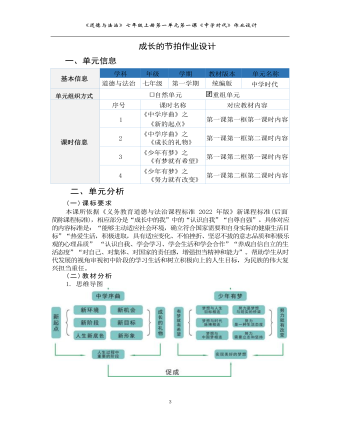
初中道德与法治七年级上册成长的节拍作业设计
2.内容内在逻辑本单元是七年级上册教材的第一单元, 作为对初中生活开端的理性阐述,具 有统领全套教材的意义。从整体上看, 本单元既是整个初中道德与法治课程的学 习起点, 也是全套教材建构的逻辑起点。这个起点包孕了道德与法治课程核心价 值观的萌芽。第一课《中学时代》也是整个初中生活开始的第一课, 可谓是重中 之重。第一框“中学序曲”共两课时。 主要引领学生踏着成长的节拍, 体会角色变 化的意味,了解中学时代对于人生的意义和价值。第二框“少年有梦”共两课时。主要帮助学生为未来的生活确立崭新的目标, 编织梦想,建立努力就有改变的生活信念,并且为实现中国梦奠定基础。(三)学情分析告别小学, 刚跨进中学大门, 开启一段全新的生命成长旅程。他们朝气蓬勃、 活力四射、思维活跃, 但是认知能力、思维方式、人格特点及社会经验等都有待 于进一步发展; 由于每个人的成长经历、个性心理等方面存在差异, 所以他们的 实际表现也各不相同。

道德与法治八年级上册丰富的社会生活作业设计
2.内容内在逻辑本课由引言和两框内容组成。引言开宗明义,指出人的成长离不开社会,意在告诉 学生,社会性是人的根本属性,离开社会提供的物质和精神支持,个人就是无源之水、 无本之本。因此,要把社会当作成长的课堂,在其中学习、锻炼、发展,这是成长的必 经之路。第一框“我与社会”,从中学生自身生活经验入手,引导学生在体验社会丰富多彩 的同时,认识到随着身体的发育、智力的提高、能力的增强,对社会生活的感受越来越 丰富,认识越来越深刻,进而认识到“我”与社会的关系,理解“我”是社会中的一分 子,在社会交往中建立了各种社会关系,进而获得不同的社会身份,扮演不同的社会角 色,承担相应的社会责任。第二框“在社会中成长”,引导学生结合个人经验探究社会对个人成长的支持和帮助,认识人的成长是不断社会化的过程,养成亲社会行为对个人成长的重要意义并努力 践行。(三) 学情分析初中学生处于由儿童向青年过渡的生理发育期和精神成长期,学校教育应帮助学生 正视自己所处的人生阶段,引导其“过积极健康的生活,做负责任的公民”。

初中道德与法治七年级上册生命的思考作业设计
B 等级——较积极参与采访活动;采访思路较清晰,记录较完整;能对自己的生 命观、价值观有所反思;能主动展示心得体会。C 等级——基本上能参与采访活动,遇到困难会想放弃;记录信息较少,只有少 量与主题有关;对自己生命观、价值观理解不深;有一点成果反馈,内容过于简 单。总体评价结果: (四) 作业分析与设计意图这是一项基于素质教育导向的整体式课时作业设计,以培养学生核心素养为 目标。作业以学生的“生命故事访谈”为主要情境,以填写活动记录的形式呈现。 教师从“参与态度、思想认识”等四个维度对作业进行评价,以“优秀、 良好、 合格”三个等级呈现。本次实践性作业是访谈型作业,课前采访希望通过学生的 参与,一方面锻炼学生的人际交往能力和口头语言表达能力,另一方面扩展学生 的生活阅历,从他人的精彩故事中获得启示,激发学生对生命的热情,树立正确 的人生观,同时也为下一框题的“平凡与伟大”提供教学素材,活出自己生命的 精彩。
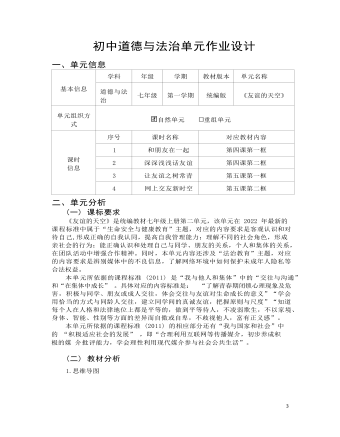
初中道德与法治七年级上册友谊的天空9作业设计
3.下列做法,能使我们在交往中不断完善的有 ( )①不断结识新朋友 ②择其善者而从之,其不善者而改之③结识新朋友,不忘老朋友 ④只和比自己成绩好、家境好的人交朋友。A. ①②④ B. ①②③ C. ②③④ D. ①③④ 4.古人云: “近朱者赤,近墨者黑。 ”这句话表明 ( )①朋友多是好事,朋友越多越好②朋友对一个人的影响很大③结交好的朋友,会使我们受益终身④结交坏的朋友,会使我们染上坏思想、坏毛病A. ①②③ B. ①②④ C. ①③④ D. ②③④ 5.马克思说:“友谊需要忠诚去播种,热情去灌溉,原则去培养,谅解去护理。” 下列观点符合这句话的有 ( )①以真诚换取友谊 ②以热情培养友谊③以宽容维护友谊 ④以原则纯化友谊A. ①②③ B. ①②④ C. ①③④ D.①②③④ 6.说到友谊,很多人都会想到管鲍之交、桃园结义、马克思和恩格斯的革命友 谊……这些友谊穿越时空、流传千古,令人向往。从中我们可以看出 ( )①友谊是人生的宝贵财富 ②益友给我们温暖和力量,让我们感受生活的美好③与朋友在一起总是幸福 ④朋友与我们是亲缘关系,需要彼此忠诚A. ①② B. ①③ C. ②④ D. ③④

初中道德与法治七年级上册友谊的天空3作业设计
11.材料一:王某在校外结识了一群哥们,总是他们相约去网吧,彻夜不归玩游戏,还 聚众打架。某日,他们相约到路边向低年级同学敲诈勒索,被人当场抓获并扭送公安机关。材料二:小英性格内向,不爱与人交流,但她在同桌小红的影响下,逐渐开始活泼起来, 在班级里结交了不少朋友。(1) 王某、小英发生上述变化的原因分别是什么?(2) 结合材料一和材料二,谈谈你对友谊的理解。12.我和小莉是形影不离的好朋友,可是有一次学校举办演讲比赛,我们都报了名,但 是小莉被选上了,我却没有。从此,我心中有了“心结” ,不愿再与小莉说话了。后来我在 网上认识了小 A,我们之间无话不谈、志趣相投。某日小 A 向我借钱,我答应了,他很快就 还给我了。于是,我更加坚信他是值得相信的朋友。后来,他再找我借钱,我又一次借给了 他,但没想到, 自此以后,他仿佛消失了一般,再也没有联系过我。伤心的我,把这事告诉了小莉,小莉建议我在家长的陪同下去报警并陪我渡过那段伤心 的时光,从此我们的友谊更加坚固。(1) 如果你是材料中的“我” ,你落选时朋友小莉却被选中参赛,你会怎么做?请说 明原因。(2) 材料启示我们,结交网友时需要注意什么?

人教A版高中数学必修一两角和与差的正弦、余弦和正切公式教学设计(1)
本节课选自《普通高中课程标准实验教科书数学必修1本(A版)》第五章的5.5.1 两角和与差的正弦、余弦和正切公式。本节的主要内容是由两角差的余弦公式的推导,运用诱导公式、同角三角函数的基本关系和代数变形,得到其它的和差角公式。让学生感受数形结合及转化的思想方法。发展学生数学直观、数学抽象、逻辑推理、数学建模的核心素养。课程目标 学科素养1.了解两角差的余弦公式的推导过程.2.掌握由两角差的余弦公式推导出两角和的余弦公式及两角和与差的正弦、正切公式.3.熟悉两角和与差的正弦、余弦、正切公式的灵活运用,了解公式的正用、逆用以及角的变换的常用方法.4.通过正切函数图像与性质的探究,培养学生数形结合和类比的思想方法。 a.数学抽象:公式的推导;b.逻辑推理:公式之间的联系;c.数学运算:运用和差角角公式求值;d.直观想象:两角差的余弦公式的推导;e.数学建模:公式的灵活运用;
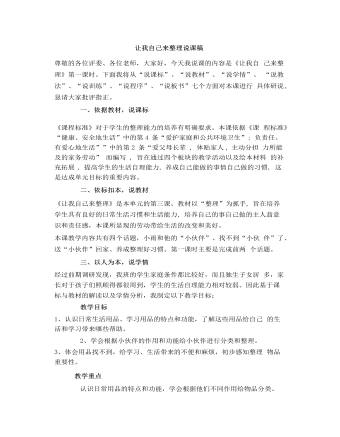
人教部编版道德与法制一年级下册让我自己来整理说课稿
思考:你有什么好办法避免这些麻烦呢? 设计意图:本环节利用微视频,让学生分析身边小伙伴的烦恼,让学生产生情感代入,从而产生不能乱丢物品的情感。(三)、说一说,金点子大比拼。同学们,我们身边的小马虎可真不 少,你有什么好的意见或建议想对她们说一说吗?(四)、写一写,贴一贴。请在智慧果上写好你的建议,并把它贴在 智慧树上,告诉身边的小马虎们吧。设计意图:写一写,是学生主动参与生活、创造生活的过程,架起了 课堂通向生活的桥梁,引起情感的共鸣。(五)、演一演。同学们给智慧树上挂满了智慧果,一个个智慧小锦囊提醒着我们如何爱惜自己的小伙伴,老师非常开心,想和大家一起分享一首儿歌,《我们的小伙伴》设计意图:利用学生喜爱的chant形式,说唱结合,趣味性浓,针对 性强,学生入脑入心,留下深刻的印象,有效的引导学生在生活中爱护物 品、学会整理。
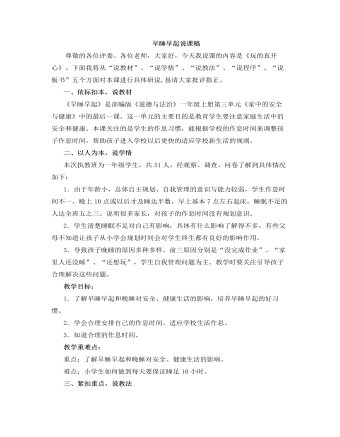
人教部编版道德与法制一年级上册早睡早起说课稿
3.故事还没完了,没早睡,明明还会怎么样?(引导往安全方面想)上体育课时……我们应该……(早睡早起,每天睡足十小时)在回家的路上……我们应该……(早睡早起,每天睡足十小时)是的麻烦会不断上门。我们应该……(早睡早起,每天睡足十小时)小时:看来充足睡眠能保安全哦!(板书:保安全)如果长期睡眠不足后果更严重。4.演一演师:同学们,明明现在很后悔了,他说一定会早睡早起。真的这样,明明的一天又会变得怎样?让我们时间倒流吧!同学互相讨论,尝试演一演。指名与老师一起演一演。小结:有早睡,多美妙!现实生活可没有时光机。为了健康与安全,我们还要坚持早睡早起,每天睡足十小时。【设计意图:观察书本上的插图,想象人物间的对话故事,换位思考,反思自己没早睡会带来哪些不良的后果。续说故事,明白充足睡眠也是保障生活安全的重要因素。演一演,创设正面教育情境,把“早睡早起”的种子深深种在心里,生根,发芽。】
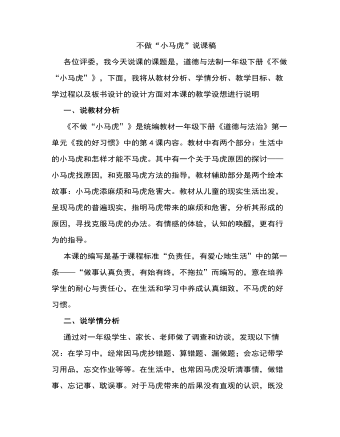
人教部编版道德与法制一年级下册不做“小马虎”说课稿
预设3:做完作业没检查。师:你做什么作业没检查结果怎么了师:原来做完事情不检查会让我们马虎预设4:做事太粗心大意了。师:你做哪件事粗心大意了结果怎么样师:原来做事粗心大意也会让我们马虎预设5:做事不认真。师:你做了件什么事不认真结果怎么样师:原来做事不认真会让我们马虎。2.“智慧仙子”有秘方师:本侦探可不是小马虎,所谓为了搞清楚马虎的原因,特意去请教了智慧仙子。看看她认为马虎的原因有哪些。(图片出示智慧仙子,并点击马虎的原因)师:小朋友们,我们知道的马虎给我们带来那么多的麻烦,也了解了马虎的原因,我们要不要做小马虎啊生:不要做师:对啦,我们不做小马虎,并板贴“不做”。小朋友们,这纸上有很多你做过的马虎事,让我们用力把他揉成一团,把小马虎扔进垃圾箱,从此告别这些马虎事,好不好

人教版高中数学选修3离散型随机变量及其分布列(1)教学设计
4.写出下列随机变量可能取的值,并说明随机变量所取的值表示的随机试验的结果.(1)一个袋中装有8个红球,3个白球,从中任取5个球,其中所含白球的个数为X.(2)一个袋中有5个同样大小的黑球,编号为1,2,3,4,5,从中任取3个球,取出的球的最大号码记为X.(3). 在本例(1)条件下,规定取出一个红球赢2元,而每取出一个白球输1元,以ξ表示赢得的钱数,结果如何?[解] (1)X可取0,1,2,3.X=0表示取5个球全是红球;X=1表示取1个白球,4个红球;X=2表示取2个白球,3个红球;X=3表示取3个白球,2个红球.(2)X可取3,4,5.X=3表示取出的球编号为1,2,3;X=4表示取出的球编号为1,2,4;1,3,4或2,3,4.X=5表示取出的球编号为1,2,5;1,3,5;1,4,5;2,3,5;2,4,5或3,4,5.(3) ξ=10表示取5个球全是红球;ξ=7表示取1个白球,4个红球;ξ=4表示取2个白球,3个红球;ξ=1表示取3个白球,2个红球.

新人教版高中英语必修3Unit 1 Festivals and celebrations-Discovering Useful Structure教学设计
4.That was an experience that frightened everyone. →That was _____________________. 答案:1. taking 2. being discussed 3. in the reading room 4. a frightening experienceStep 6 The meaning and function of V-ing as the predicative动词-ing形式作表语,它通常位于系动词后面,用以说明主语“是什么”或“怎么样”一种表示主语的特质、特征和状态, 其作用相当于形容词; 另一种具体说明主语的内容, 即主语等同于表语, 两者可互换。The music they are playing sounds so exciting. 他们演奏的音乐听起来令人激动。The result is disappointing. 结果令人失望。Our job is playing all kinds of music. 我们的工作就是演奏各种音乐。Seeing is believing. 眼见为实。Step 7 Practice1. It is ________(amaze) that the boy is able to solve the problem so quickly.2. Buying a car is simply _______(waste) money. 3. Please stop making the noise—it’s getting ________(annoy). 4. complete the passage with the appropriate -ing form.La Tomatina is a festival that takes place in the Spanish town Bunol every August. I think many food festivals are __________ because people are just eating. however, this festival is _________ because people don't actually eat the tomatoes. Instead, they throw them at each other! the number of people ________ part in this tomato fight, can reach up to 20,000, and it is a very __________ fight that lasts for a whole hour. The _______ thing is how clean Bunol is after the tomatoes are washed away after the fight. this is because the juice form tomatoes is really good for making surfaces clean!答案:1. amazing 2. wasting 3. annoying4. boring interesting taking exciting amazing

新人教版高中英语必修3Unit 1 Festivals and Celebrations-Listening &Speaking&Talking教学设计
The theme of this section is “Talk about festival activities and festival experiences”.Festival and holiday is a relaxing and interesting topic for students. This part talks about the topic from the daily life of students’. In the part A ---Listening and Speaking, there are three conversations among different speakers from three countries(Japan, Rio and China), where the speakers are participating in or going to participate in the festivals and celebrations. So listening for the relationship among them is a fundamental task. Actually, with the globalization and more international communication, it is normal for Chinese or foreigners to witness different festivals and celebrations in or out of China. In the Conversation 1, a foreign reporter is interviewing a Japanese young girl who just had participated in the ceremony of the Coming-of-Age Day on the street and asking her feeling about the ceremony and the afterwards activities. Conversation 2, Chinese girl Li Mei is witnessing the Rio Carnival for the first time, and her friend Carla gives her some advice on the costumes which enables her to match with the carnival to have a good time. Conversation 3, a Chinese guide is showing a group of foreign visitors around the Lantern Festival and introducing the customs of the festival to them. The three conversations have a strong vitality and insert the festival and cultural elements from different countries. So perceiving the festivals and cultures from different countries is the second task. At the same time, the scripts also insert the targeted grammar --- v-ing as attributive and predicative, which students can perceive and experience in a real context and make a road for the further study. That is the third task. In the Part B--- Listening and Talking, the theme is “Talk about festival experience”, which is the common topic in our daily conversations. During the conversation, Song Lin, a Chinese student, asked Canadian friend Max about how to spend Christmas. In the conversation, Song Lin talked about experience and the feelings during the Chinese Spring Festival, during which there are not only some enjoyable things but some unpleasant things. After the listening, perhaps students find there are some similarities between Christmas and the Chinese Spring Festival as there are some differences in the origins and celebrations. For example, people always visit friends and relatives, decorate their houses, have a big dinner together, chat and give presents to each other.

新人教版高中英语必修3Unit 1 Festivals and Celebrations-Reading for writing教学设计二
Step 3 Analyzing article structureActivity 31. Teachers raise questions to guide students to analyze the chapter structure of this diary and think about how to describe the festival experience. (1)What should be included in the opening/body/closing paragraph(s)?(2)How did the writer arrange his/her ideas?(3)What kind of interesting details did the writer describe?(4)How did the writer describe his/her feelings/emotions during the event?2. Students read and compare the three sentence patterns in activity 2. Try to rewrite the first paragraph of the diary with these three sentence patterns. After that, students exchange corrections with their partners. Such as:●This was my first time spending three days experiencing the Naadam Festival in China’s Inner Mongolia Autonomous Region and it was an enjoyable and exciting experience. ●I'll never forget my experience at the Naadam Festival because it was my first time to watch the exciting Mongolian games of horse racing, wrestling, and archery so closely. ●I'll always remember my first experience at the Naadam Festival in China’s Inner Mongolia Autonomous Region because it was so amazing to spend three days witnessing a grand Mongolian ceremony. Step 4 Accumulation of statementsActivity 41. Ask the students to read the diary again. Look for sentences that express feelings and emotions, especially those with the -ing form and the past participle. Such as:● …horse racing, wrestling, and archery, which are all so exciting to watch. ● some amazing performances● I was surprised to see…● I was a little worried about. . . ● feeling really tiredOther emotional statements:●I absolutely enjoyed the archery, too, but the horse races were my favourite part. ●I'm finally back home now, feeling really tired, but celebrating Naadam with my friend was totally worth it. ●He invited me back for the winter to stay in a traditional Mongolian tent and cat hot pot. I can’t wait!2. In addition to the use of the -ing form and the past participle, the teacher should guide the students in the appreciation of these statements, ask them to memorize them, and encourage them to use them reasonably in writing practice.

新人教版高中英语选修2Unit 1 Science and Scientists-Discovering useful structures教学设计
The grammatical structure of this unit is predicative clause. Like object clause and subject clause, predicative clause is one of Nominal Clauses. The leading words of predicative clauses are that, what, how, what, where, as if, because, etc.The design of teaching activities aims to guide students to perceive the structural features of predicative clauses and think about their ideographic functions. Beyond that, students should be guided to use this grammar in the context apporpriately and flexibly.1. Enable the Ss to master the usage of the predicative clauses in this unit.2. Enable the Ss to use the predicative patterns flexibly.3. Train the Ss to apply some skills by doing the relevant exercises.1.Guide students to perceive the structural features of predicative clauses and think about their ideographic functions.2.Strengthen students' ability of using predicative clauses in context, but also cultivate their ability of text analysis and logical reasoning competence.Step1: Underline all the examples in the reading passage, where noun clauses are used as the predicative. Then state their meaning and functions.1) One theory was that bad air caused the disease.2) Another theory was that cholera was caused by an infection from germs in food or water.3) The truth was that the water from the Broad Street had been infected by waste.Sum up the rules of grammar:1. 以上黑体部分在句中作表语。2. 句1、2、3中的that在从句中不作成分,只起连接作用。 Step2: Review the basic components of predicative clauses1.Definition

新人教版高中英语选修2Unit 1 Science and Scientists-Learning about Language教学设计
Step 7: complete the discourse according to the grammar rules.Cholera used to be one of the most 1.__________ (fear) diseases in the world. In the early 19th century, _2_________ an outbreak of cholera hit Europe, millions of people died. But neither its cause, 3__________ its cure was understood. A British doctor, John Snow, wanted to solve the problem and he knew that cholera would not be controlled _4_________ its cause was found. In general, there were two contradictory theories 5 __________ explained how cholera spread. The first suggested that bad air caused the disease. The second was that cholera was caused by an _6_________(infect) from germs in food or water. John Snow thought that the second theory was correct but he needed proof. So when another outbreak of cholera hit London in 1854, he began to investigate. Later, with all the evidence he _7_________ (gather), John Snow was able to announce that the pump water carried cholera germs. Therefore, he had the handle of the pump _8_________ (remove) so that it couldn't be used. Through his intervention,the disease was stopped in its tracks. What is more, John Snow found that some companies sold water from the River Thames that __9__________________ (pollute) by raw waste. The people who drank this water were much more likely _10_________ (get) cholera than those who drank pure or boiled water. Through John Snow's efforts, the _11_________ (threaten) of cholera around the world saw a substantial increase. Keys: 1.feared 2.when 3. nor 4.unless 5.that/which 6.infection 7.had gathered 8.removed 9.was polluted 10.to get 11. threat

新人教版高中英语选修2Unit 1 Science and Scientists-Reading and thinking教学设计
Step 5: After learning the text, discuss with your peers about the following questions:1.John Snow believed Idea 2 was right. How did he finally prove it?2. Do you think John Snow would have solved this problem without the map?3. Cholera is a 19th century disease. What disease do you think is similar to cholera today?SARS and Covid-19 because they are both deadly and fatally infectious, have an unknown cause and need serious public health care to solve them urgently.keys:1. John Snow finally proved his idea because he found an outbreak that was clearly related to cholera, collected information and was able to tie cases outside the area to the polluted water.2. No. The map helped John Snow organize his ideas. He was able to identify those households that had had many deaths and check their water-drinking habits. He identified those houses that had had no deaths and surveyed their drinking habits. The evidence clearly pointed to the polluted water being the cause.3. SARS and Covid-19 because they are both deadly and fatally infectious, have an unknown cause and need serious public health care to solve them urgently.Step 6: Consolidate what you have learned by filling in the blanks:John Snow was a well-known _1___ in London in the _2__ century. He wanted to find the _3_____ of cholera in order to help people ___4_____ it. In 1854 when a cholera __5__ London, he began to gather information. He ___6__ on a map ___7___ all the dead people had lived and he found that many people who had ___8____ (drink) the dirty water from the __9____ died. So he decided that the polluted water ___10____ cholera. He suggested that the ___11__ of all water supplies should be _12______ and new methods of dealing with ____13___ water be found. Finally, “King Cholera” was __14_____.Keys: 1. doctor 2. 19th 3.cause 4.infected with 5.hit 6.marked 7.where 8.drunk 9.pump 10.carried 11.source 12.examined 13.polluted 14.defeatedHomework: Retell the text after class and preview its language points

新人教版高中英语选修2Unit 1 Science and Scientists-Using langauge教学设计
This happens because the dish soap molecules have a strong negative charge, and the milk molecules have a strong positive charge. Like magnets, these molecules are attracted to each other, and so they appear to move around on the plate, taking the food coloring with them, making it look like the colors are quickly moving to escape from the soap.Listening text:? Judy: Oh, I'm so sorry that you were ill and couldn't come with us on our field trip. How are you feeling now? Better?? Bill: Much better, thanks. But how was it?? Judy: Wonderful! I especially liked an area of the museum called Light Games.it was really cool. They had a hall of mirrors where I could see myself reflected thousands of times!? Bill: A hall of mirrors can be a lot of fun. What else did they have?? Judy: Well, they had an experiment where we looked at a blue screen for a while, and then suddenly we could see tiny bright lights moving around on it. You'll never guess what those bright lights were!? Bill: Come on, tell me!? Judy: They were our own blood cells. For some reason, our eyes play tricks on us when we look at a blue screen, and we can see our own blood cells moving around like little lights! But there was another thing I liked better. I stood in front of a white light, and it cast different shadows of me in every color of the rainbow!? Bill: Oh, I wish I had been there. Tell me more!? Judy: Well, they had another area for sound. They had a giant piano keyboard that you could use your feet to play. But then, instead of playing the sounds of a piano, it played the voices of classical singers! Then they had a giant dish, and when you spoke into it, it reflected the sound back and made it louder. You could use it to speak in a whisper to someone 17 meters away.? Bill: It all sounds so cool. I wish I could have gone with you? Judy: I know, but we can go together this weekend. I'd love to go there again!? Bill: That sounds like a great idea!

新人教版高中英语必修3Unit 1 Festivals and Celebrations-Reading and Thinking教学设计
The topic of this part is “Discover the reasons for festivals and celebrations.The Listening & Speaking & Talking part aims at talking about the experiences and feelings or emotions about the festivals and celebrations. This section aims at detecting the reason why the people celebrate the festivals, the time, the places, the types and the way of celebrations. It also explains why some traditions in the old celebrations are disappearing, like the firecrackers in the big cities and some new things are appearing like the prosperity of business or commerce. 1. Students can talk about what festivals they know and the reasons and the way of celebrating them.2. Students should learn the reading skills such as the headline and get the topic sentences, the structures of articles.3. Students can understand the past, the present situation of some festival around the world and why there are some changes about them. 4. Students can have the international awareness about the festivals.1. Students should learn the reading skills such as the headline and get the topic sentences, the structures of articles.2. Students can understand the past, the present situation of some festival around the world and why there are some changes about them.Step 1 Lead in---Small talkWhat festival do you like best ? Why ?I like the Spring Festivals because I can set off the fireworks, receive the lucky money and enjoy the Gala with my families.Step 2 Before reading---Pair workWhy do people celebrate different festivals ?The Spring Festivals is to celebrate the end of winter and the coming of spring and new life.The Mid-autumn Day is to celebrate the harvest and admire the moon.
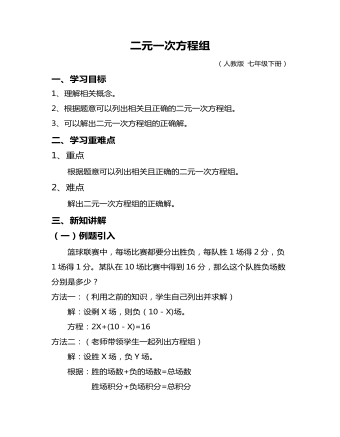
初中数学人教版二元一次方程组教学设计教案
(一)例题引入篮球联赛中,每场比赛都要分出胜负,每队胜1场得2分,负1场得1分。某队在10场比赛中得到16分,那么这个队胜负场数分别是多少?方法一:(利用之前的知识,学生自己列出并求解)解:设剩X场,则负(10-X)场。方程:2X+(10-X)=16方法二:(老师带领学生一起列出方程组)解:设胜X场,负Y场。根据:胜的场数+负的场数=总场数 胜场积分+负场积分=总积分得到:X+Y=10 2X+Y=16

人教版高中数学选修3一元线性回归模型及其应用教学设计
1.确定研究对象,明确哪个是解释变量,哪个是响应变量;2.由经验确定非线性经验回归方程的模型;3.通过变换,将非线性经验回归模型转化为线性经验回归模型;4.按照公式计算经验回归方程中的参数,得到经验回归方程;5.消去新元,得到非线性经验回归方程;6.得出结果后分析残差图是否有异常 .跟踪训练1.一只药用昆虫的产卵数y与一定范围内的温度x有关,现收集了6组观测数据列于表中: 经计算得: 线性回归残差的平方和: ∑_(i=1)^6?〖(y_i-(y_i ) ?)〗^2=236,64,e^8.0605≈3167.其中 分别为观测数据中的温度和产卵数,i=1,2,3,4,5,6.(1)若用线性回归模型拟合,求y关于x的回归方程 (精确到0.1);(2)若用非线性回归模型拟合,求得y关于x回归方程为 且相关指数R2=0.9522. ①试与(1)中的线性回归模型相比较,用R2说明哪种模型的拟合效果更好 ?②用拟合效果好的模型预测温度为35℃时该种药用昆虫的产卵数.(结果取整数).
